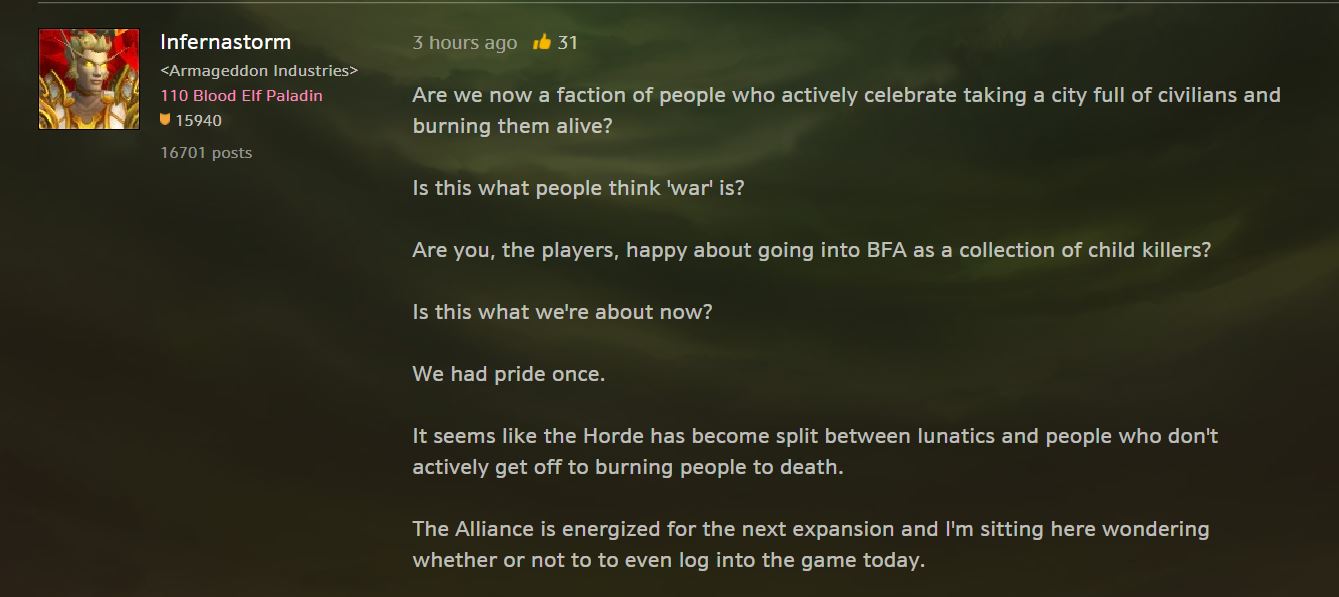World of Warcraft's most controversial plot twist has the community tearing itself apart
It turns out "morally grey" might not be the right term to describe the Horde anymore.
Warning: This post contains major plot spoilers for the most recent quest in World of Warcraft.
The Battle for Azeroth pre-expansion event has reached a dramatic climax that has World of Warcraft players outraged—and for good reason. The second part of The War of the Thorns quest went live yesterday, heralding all out war between the Horde and Alliance, but one side clearly seems to be in the wrong here.
For months, players have known that The War of the Thorns would end with the burning of Teldrassil, the massive tree that houses the night elf capital city of Darnassus. What they didn't know is who was responsible for destroying it and murdering countless innocents. It's been a mystery that Blizzard has teased for months since Battle for Azeroth was first announced. But yesterday Blizzard released the second animated short in the Warbringer series that finally reveals the culprit: Sylvanas Windrunner.
Since that reveal, the World of Warcraft subreddit, forums, and even fansites have erupted in outrage over the direction Blizzard is taking the story. It's a complex issue that drives straight to the heart of why players love and hate World of Warcraft's approach to storytelling.
All is fair in love and war
The first part of The War of the Thorns detailed the opening chapter of the war with Sylvanas Windrunner and the Horde surprising the Alliance by invading Darkshore. It was, aside from some small conflicts in Silithus, the first major act of war between the Alliance and Horde.
During that first chapter, the Horde storms north along the shore with the goal of capturing Teldrassil and ending the war before it starts by depriving the Alliance of an incredibly valuable foothold. It is a contentious move to attack without provocation, but Windrunner's motivation is also reasonable. This war is, essentially, a resource war being fought over the crystallized blood of the planet itself. Called Azerite, it’s a supremely powerful substance that both sides are keen on using against the other. In the wrong hands it's basically a weapon of mass destruction.
Instead of staying locked in a cold war, though, Sylvanas sees an opportunity to take the initiative and ensure the survival of the Horde. By sieging Teldrassil and killing one of its leaders, Malfurion, the Horde planned to take out a key part of the Alliance's Azerite supply chain and devastate their morale. The conflict would end with minimal casualties on both sides—a smart and decisive strategy.
Keep up to date with the most important stories and the best deals, as picked by the PC Gamer team.

Players were expecting some big twist but, instead, Sylvanas (and by extension the Horde) turned out to be just as evil as everyone feared.
Obviously things don't go according to plan, though. Players have known since Blizzcon 2017 that Teldrassil would eventually burn down and a beta version of The War of the Thorns quest on test servers confirmed as much. But while players knew that Teldrassil would burn, what they didn't know was how.
That tiny detail was a key source of speculation across the entire community. On the beta servers, players have been able to play through The War of the Thorns quest in its entirety but without one crucial in-game cinematic that presumably showed who burned Teldrassil. Sylvanas' quest dialogue at the end of the beta version implied the burning was unintended or even entirely accidental. Players ran with that assumption and started weaving all sorts of wild theories. Some suggested the Alliance burned Teldrassil in an attempt to blame and further vilify the Horde. Others speculated that a third party interfered hoping to capitalize on the ensuing chaos. Even if the Horde was ultimately responsible, players expected that something would have to force their hand making it a regrettable tragedy for both sides. It was a classic and very compelling ‘whodunnit?’ scenario players were eager to expose.
When part two of The War of the Thorns released yesterday with that missing Warbringers cinematic included, players finally received their answer. Following Sylvanas, the cinematic takes place on the shores of Darkshore shortly after the Horde defeated the last of the Night Elf resistance. Sylvanas makes ready to invade Teldrassil and capture it for the Horde. Just then Sylvanas is confronted by a dying night elf ranger captain. "You can kill us, but you cannot kill hope," she says after Sylvanas unsuccessfully tries to break her spirit. Upset by the ranger's defiance and realizing the elves' morale remains unbroken, Sylvanas orders her soldiers to burn Teldrassil down while the dying ranger is forced to watch in horror. Players were expecting some big twist but, instead, Sylvanas (and by extension the Horde) turned out to be just as evil as everyone feared.
Not my warchief
That one controversial scene has sparked enormous backlash across Warcraft's official subreddit and forums. Each is completely overrun with threads from players criticizing Blizzard or championing one interpretation or another. On Twitter, World of Warcraft novelist Christie Golden had to "step back" from social media due to the vitriolic harassment she was receiving even though she confirmed she had no oversight on the Warbringers story. One of the most popular threads on the official forums encourages players to cancel their subscriptions as a form of protest. It's obvious players are fuming. Months of rising tensions between Blizzard and some WoW players over the direction of Battle for Azeroth's story have finally boiled over.

The biggest issue is that, since Blizzcon 2017, players believed they didn't yet know the full story of The War of the Thorns and that has obviously led many to assume there was some kind of twist that would re-contextualize the events leading up to the burning of Teldrassil. During one developer Q&A, a player outright asked why the Horde was doing things that seemed pretty evil and expressed concern about the faction's motivations. In response, game director Ion Hazzikostas said that Azeroth is "a world of grey, it's never been a world of black and white" and explained that "there's a lot of story to tell going forward."
Players took that statement to mean that, while the Horde seemed to be doing some pretty shady stuff in the prologue of this expansion, there was crucial information that would help players empathize with its actions. But after months of anticipation, there doesn't seem to be a whole lot of moral greyness behind The Horde and Sylvanas. The burning of Teldrassil and the slaughter of countless night elf innocents isn't some grand ethical conundrum to mull over. It's just plain evil, and that’s not the plot twist players expected.
But that isn't the issue, exactly. Sylvanas is well-established as an evil character, but players appear just as upset over how contrived the whole War of Thorns questline feels in service of setting the stage for Battle for Azeroth. Key characters behave erratically and, at times, incomprehensibly. On the WoW subreddit, user 'gustavposts' points out how Tyrande Whisperwind, a night elf leader and renowned guerilla warfare expert, only shows up during the battle for Darkshore to save Malfurion from death and then retreats to Stormwind, completely abandoning her people to their fate.
Why does the rest of the Horde leadership, many of whom are honorable characters, stand silent while Sylvanas burns Teldrassil?
On the Horde side, Sylvanas acts irrationally throughout the entire campaign. As WoW YouTuber BellularGaming points out, her goal is to kill Malfurion but when she finally has the chance she defers the execution to an underling who lets him escape—and then never follows up with that plot thread. And why does the rest of the Horde leadership, many of whom are honorable characters, stand silent while Sylvanas burns Teldrassil? For many players, it just doesn't feel all that believable.
Since World of Warcraft's release back in 2003, Blizzard has been carefully trying to shape the Horde as a force that's diametrically opposed to the Alliance without painting either faction as good or evil. But it's upsetting to players how often that doesn't seem to be the case.
It's a lot of questions that, I suspect, won't ever get answers—at least not right away. But the problem is exacerbated by World of Warcraft's limited capacity to tell nuanced stories using only quest dialogue and a few in-game cinematics. More often than not, players are left guessing or rifling through the mountain of comics, books, and spin-off media to try and make sense of it all.
For Horde players in particular though, the matter is doubly concerning since they are effectively complicit in the burning of Teldrassil. Because World of Warcraft's story is a completely linear experience that doesn't allow for much player input, Horde characters have no choice but to comply with Sylvanas' actions for the time being even though many seem to vehemently hate her and how poorly she represents the faction's ideals. That's an especially annoying problem because the vast majority of Battle for Azeroth's new content is available on the test server (I've been playing through it as a Horde character myself) and there's no indication that what happened at Teldrassil will be addressed any time soon. Horde players will likely have to spend months taking orders from what they perceive to be an evil war criminal until Blizzard rolls out the next batch of story content.
For veteran World of Warcraft players, there's also the inescapable feeling of deja vu. During a previous expansion, Mists of Pandaria, the then-Warchief Garrosh Hellscream was a tyrannical monster who the Horde (with the help of the Alliance) eventually deposed during the final boss fight of that expansion. To put it simply, Horde players are just tired of feeling like the bad guys all the time.
Reading through the forums and subreddit, there's a million and one reasons why people are upset. But one thing is clear: The Burning of Teldrassil is easily the most controversial moment in World of Warcraft's history. In the day since the Warbringers cinematic was revealed, the debate is beginning to find balance and the conversation has shifted away from the knee-jerk reaction that The War of the Thorns is merely overly contrived storytelling. One of the top posts on Reddit right now fires back at the community for criticizing Blizzard for not pandering to their assumptions. Other threads openly embrace being villains and revel in the destruction wrought by the Horde. And then there's the healthy dose of shit-talking by players just looking to rile everyone up.
While the backlash feels overly severe—especially with regards to the ongoing targeted harassment of female writers—it's clear Blizzard intended this moment to stir controversy in its community. The War of the Thorns has the community riled up in a way I haven't seen in years and there's an overarching sense of irony in the way players are so passionately arguing. It almost feels like unintentional roleplaying. While not everyone agrees with Blizzard's methods, it seems like the Horde and its identity and place in Azeroth will be a key theme in this expansion. But whether players will like what Blizzard has to say is another matter entirely.
With over 7 years of experience with in-depth feature reporting, Steven's mission is to chronicle the fascinating ways that games intersect our lives. Whether it's colossal in-game wars in an MMO, or long-haul truckers who turn to games to protect them from the loneliness of the open road, Steven tries to unearth PC gaming's greatest untold stories. His love of PC gaming started extremely early. Without money to spend, he spent an entire day watching the progress bar on a 25mb download of the Heroes of Might and Magic 2 demo that he then played for at least a hundred hours. It was a good demo.


